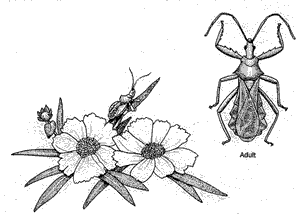 |
| © Robin Brickman |
| Assassin Bug |
How appropriate to employ the assassin bug in your army of pest controllers. Assassin bugs move rather clumsily and fly slowly--hard to imagine them being very helpful at catching and killing insect pests, but they do have lightning-fast front legs with which to snatch their victims. With their powerful beaks they pierce their catch and inject a paralyzing venom before devouring them completely. Sounds kind of scary if you are a pest insect just minding your own business.
WHY ARE ASSASSIN BUGS BENEFICIAL?
Adult and nymphs of the assassin bugs feed on beetles, leafhoppers, aphids, unfortunately bees, caterpillars and bedbugs. The nymphs and adults feed on the insect eggs and larvae of the follow-ing bad guys:
• In The Lawn – Eggs of chinch bugs, sod webworms and Japanese beetle grubs
• In The Yard - various beetles, leafhoppers, aphids, caterpillars . Japanese beetle
• In The Vegetable Garden – asparagus beetle, Colorado potato beetle, the Mexican bean beetle.
The wheel bug, a country cousin, attacks large caterpillars and sucks them dry. The spined assas-sin bug eats the larvae of many insects and all stages of the Mexican bean beetle. These guys are real generalists rather than specializing in one or two bad guys.
DESCRIBING ASSASSIN BUGS
Some species of the assassin bug is called the “kissing bug” and will sometimes bite a human if handled.. The bite is rather mean so don’t handle them. They have a strong beak and forelegs used for holding and killing prey.
These critters are one half to three quarters of an inch long, about the size of a woman’s mani-cured fingernail. They may be black, yellowish-brown or green. They are slender and the well developed, long, curved beak hides beneath the slender head. The front legs are enlarged for grasping. You can find them throughout North America.
The female lays eggs in tight, upright clusters on leaves or in the soil. The nymphs resemble adults without wings and are sometimes brightly colored.
WHERE DO YOU FIND ASSASSIN BUGS?
Assassin bugs work both day and night. They hang out in shrubs and low plants.as well as in lawns with tall dense grass. They overwinter as adults, nymphs or eggs generally in places we can’t see.
HOW TO ATTRACT AND KEEP ASSASSIN BUGS
They are naturally present in your yard. We assume that if you have lots of organic mulch around your plants throughout the yard, you will be harboring a fair number of Assassin Bugs.
You improve your chances of having assassin bugs if you plant Queen Ann’s lace and members of the daisy family that may hold them to your yard if the pest population is low. The assassin bug needs small flowers, as do most beneficials, because they cannot reach too deeply into a flower for nectar and pollen. During the season you can also find these friends on alfalfa, camphorweed, plants in the carrot family, goldenrod, Mexican tea, and oleander.
BUYING ASSASSIN BUGS
These good guys cannot be purchased commercially so the homeowner needs to take all steps possible to attract and keep them in your yard.

